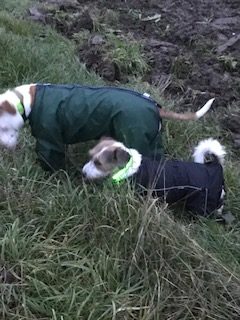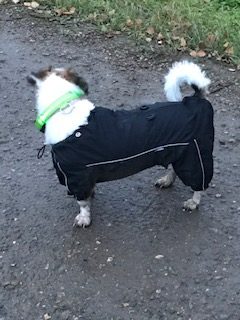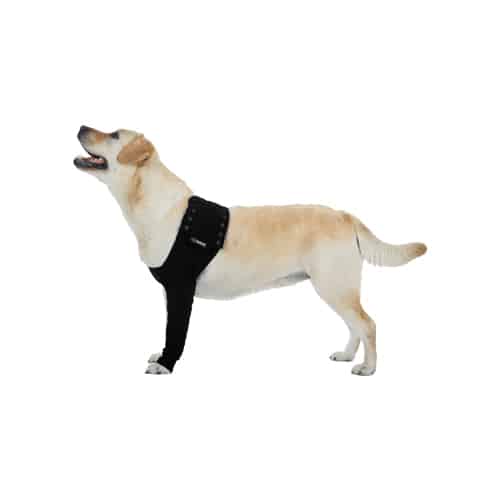Why do dogs wag their tails? Tail wagging is more complicated than you might think. Most pet owners assume that tail wagging pertains to happiness. While this is true, it is not the whole story. Tail wagging can be indicative of positive mood, but it also helps to convey a range of other emotions. Tail wagging is actually a complex means of communication. The tails height and the way it is positioned and how it is moving can tell owners a lot. But this can look different depending on the dog’s breed. Every dog breed has a natural position that indicates relaxation. When their tail goes above or below that position, the emotional state of your pet can be deciphered. Other factors such as motion and speed of tail wagging can also tell you about the state of your pet.
In this article, we attempt to dive deeper into the topic of tail wagging.
You will learn how dogs develop this skill, why their tails wag, and what it all means.
Knowing the purpose of a dog’s tail wagging can be beneficial to any dog owner.
With this helpful guide you will learn more about understanding your pet, and their emotional needs.
Why Do Dogs Wag Their Tails
Unlike humans, canines lack complex language skills to articulate themselves. This does not mean though that dogs can’t communicate, they can.
It should be obvious, but dogs can’t communicate on the same level as humans. They don’t have words to explain how they feel.
And while they will sometimes bark at us, or whine for attention, this doesn’t tell us how our dog is doing emotionally.
In their own way, our pets do tell us how they feel. This is evident in the way dogs use their tails.
Tail wagging is an important form of communication for dogs. Just watch the way dogs tails move when they meet.
It is also something that should be understood by all pet owners. Understanding the positions and motions of your pets tail will help you create a stronger bond with your dog.
It also helps you keep track of their well-being and overall mood.
Some people think tail wagging is an inherent trait. That all canines know how to wag their tails straight out of the womb. This is not the case.
Dogs are not born with the ability to communicate with their tails. Instead, tail wagging is learned through the process of socialization and instinct.

Like human infants, dogs learn from those around them. But part of it is based on primal needs.
Puppies require a way to communicate with their litter. They also pick up on emotional cues from their mother and other dogs.
This process starts to take place when your dog is born and accelerates when about a month old.
In general, like humans, dogs use their whole body to communicate. Their ears, facial expression, and vocal tones can help them better communicate.
But tail wagging is a more convenient way for a dog to express emotions to humans, as well as, other dogs. Your pet’s sight is better at processing motion than it is at defining color or sound.
Seeing a tail wag easily communicates information to other dogs. This is apparent in the biological evolution of canines.
Over time, tails have been made more and more visible through size and color so dogs can better communicate.
These communication benefits are not only seen between canines though. Tails are also great for communication between pets and owners.
Tails are easily visible and help to signal distress or happiness to pet owners.
What is the Natural Position of Your Dog’s Tail?
As we stated before, every dog has a natural position. This refers to the baseline position of your pet’s tail. When their tail is settled in its natural position, this means your dog is relaxed.
Depending on the breed you own, you might see some differences. For the most part, though, it should be easy to know if your dog is relaxed.

The majority of dogs keep their tails near their heel when they are at ease. For some breeds, this is not the case.
Our Shih Tzu has his tail downwards most of the time but always sticking out away from his body, When he is excited his tail goes straight up into the air. It only gets tucked between his legs when he’s been told off, yet Greyhounds keep their tails tucked a little bit between their legs most of the time even when they’re relaxed.
Dogs like the pug have tails that are positioned toward the upper regions of their body. Beagles tails are pointed upward and away from their body as well.

Other dogs’ tails are not very big and stay close and coiled on their body, in this instance they may move very little or might not move at all in some breeds.
Try spending some time watching your dog to find out what their natural position is, it can be helpful to know.

Once you know what your pet’s natural position is, you can better tell what their emotional state is like.
Everything is relative to that position. If your dog’s tail is higher than their natural position with some wagging, this might indicate more positive emotions. They could be happy or excited. Though this is not always true.
Wagging Tails That Are High
If your dog’s tail is stiff and very high up this could be a sign of aggression or a generally heightened state, not happiness. So, a dog wagging its tail in this position does not always mean it is friendly.
Watch out for stiff and high tails when introducing your pet to new people or new dogs. The higher up your dog’s tail goes, the higher their level of alertness and the possibility of aggression may be close to hand.
Low Wagging Tails
On the flip side, a tail that is wagging below their usual position will indicate submission, fear, or nervousness.
With most pets, if their tail is between their legs and not moving it is clear that they are submitting. Your dog might think they are being threatened or harmed. So they revert to this position to show that they won’t be a threat.
A Tail That Stops Wagging
Another position you might see is a neutral one. Your dog’s tail may suddenly stop all motion. This does not mean your dog is getting aggressive.
A freezing motion means your dog wants to stop a potential threat. Typically, this happens with strangers, dog or human.
When your pet stops moving, they are letting you know that they don’t want to be petted or touched.
Knowing these positions is good for your dog and you.
This information can help you out when your dog is acting different than normal.

They could be nervous and need comforting. Or you might stop your pet getting aggressive. These signs could help you keep them from harming others.
It might even be a clue that something is wrong with your pet. A tail is not the only way to notice that your dog is anxious.
What Do other Motions of Your Dog’s Tail Mean?
Position is not always the only important factor in these equations. The Motion of canine tails can also clue you into your dog’s mood.
A Fast Wagging Tail
If a dogs tail is moving quickly and rapidly it is generally excited about something. Maybe they are happy you are home or excited to be outside and play.
Dogs tails can move pretty fast. The side to side movement is known as flagging. This is not only an indication of excitement but one of friendliness.
When you introduce your pet to new animals it’s good to watch out for this motion.
Your dog’s tail can tell you if they are ready to interact with a new pet or person. Fast motion means they are ready to accept and maybe to play!
A Slow Wagging Tail
On the other hand, if your pet’s tail is sluggish in its movement, you might want to reconsider your playdate. Your dog could be experiencing nervousness or stress.
Some dogs get shy around strangers. They can show this to you through tail wagging. If their tail wags hesitantly they could be telling you that they don’t want to play.
If their head is lowered too then they are probably feeling very nervous or even threatened.
And if your dog’s tail is slow often, this could be indicative of a bigger problem.
Dogs can suffer from mood disorders and other issues common in humans. A visit to the vet might not be a bad idea if you think your dog is consistently in a low mood.
Of course, these are not the only signs of emotion in your dog, but they are important.
Tail wagging is the most visible and detailed sign of your pet’s mood. There is a lot of nuance in the motion of your animal’s tail.
Research has even shown that the direction a tail wags can indicate emotion.
Offset Tail Wagging
When your dog’s tail wags offset to the right this means your pet is experiencing positive emotions. They could be happy, excited, or curious. When your dog’s tail wags offset to the left they are said to be experiencing more negative emotions. They could be anxious or a little stressed out.
Conclusion
We don’t speak the same language as our pets. But we can make an effort to understand them better. Dog’s communication methods are not nearly as sophisticated as humans, but they are full of complexity.
In particular, our dogs tell us a lot with their tails. When you see your dog’s tail wag, this doesn’t always mean they are happy.
They could be scared, nervous, curious, or feeling something else entirely. Overall, your pet has a wide range of emotions just like their owners!
Understanding the language of your dog’s tail brings you one step closer to bonding with them!
Related Questions:





